Vesicular stomatitis in Horses is characterized by the development of vesicles on the feet and mouth. In horses, it is associated with a very painful lameness, and in cattle and swine, it can be confused clinically with foot and mouth disease.
What Causes Vesicular Stomatitis?
- Vesicular Stomatitis Virus(VSV) belongs to the same family as rabies virus, the Rhabdoviridae.
- Two serotypes have been associated with disease in horses in the United States, the New Jersey type and the Indiana type.
- There is extensive genetic diversity of viruses within these serotypes, but the diseases they induce appear to be clinically indistinguishable.
- The majority of outbreaks of vesicular stomatitis in the United States have been associated with the New Jersey serotype.
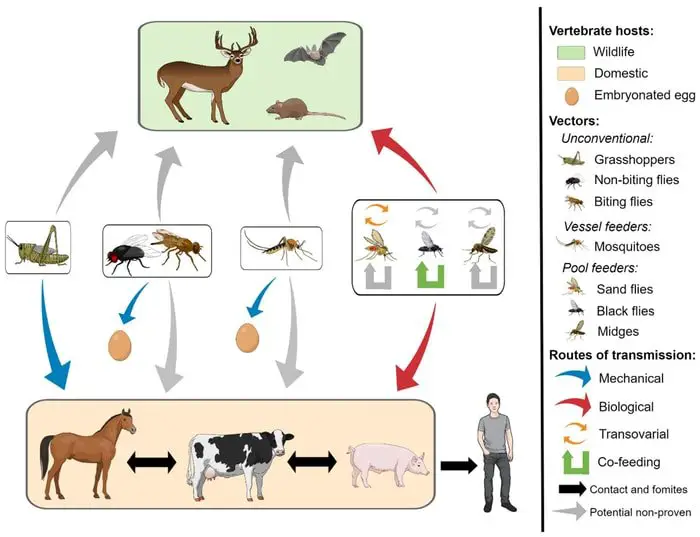
Epidemiology of Equine Vesicular Stomatitis
- Horses, cattle, and pigs are susceptible to vesicular stomatitis. Sheep and goats are much more resistant.
- The disease may be transmitted to people.
- The disease occurs in the Western Hemisphere and is endemic to Central America, the southern United States, and Colombia, Peru, Ecuador, and Venezuela. Major outbreaks in the United States occurred in 1964, 1982, 1985.
- The 1982 explosion happened in the western states primarily on ranches in southwestern Colorado. Although horses and cows were the most severely affected pigs, sheep, goats, dogs, and people also contracted the disease.
- The incidence of infection in horses (45%) was higher than that in cows (5%).
- The mode of transmission of the virus is not fully understood.
- The virus cannot penetrate intact skin but can enter through abrasions, wounds, and mucous membranes, thus the feeding of poor quality rough forage, which causes abrasions in the mouth facilities virus spread.
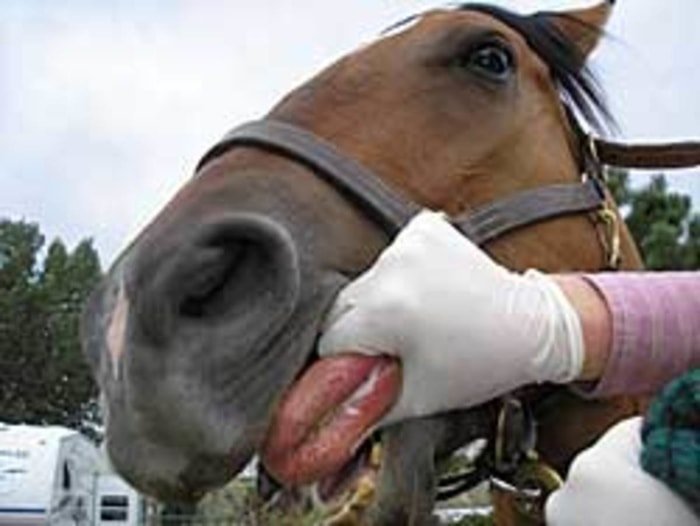
- Transmission may occur by direct contact and saliva, and vesicular fluid from clinically affected animals are highly infective.
- However, several outbreaks have occurred in horses which have had no contact with infected animals, and it is widely believed that the virus is transmitted by insect vectors.
- In support of this theory, the virus has been isolated from sand flies, horn flies, black flies and mosquitoes, and disease outbreaks usually occur in August and September when these insects are abundant.
- Very few outbreaks have been recorded after the onset of cold weather with frost.
- The disease is prevalent in low-lying wooded areas with heavy rainfall.
- In a survey in Utah in 1982, it was shown that horses stabled in an environment with some insect control were much less likely to contract the disease than horses kept on a pasture near a river.
- Trajectory analysis of winds suggests that carriage of infected insects on the wind may play a role in the spread of the disease.
- The reservoir of the virus is unknown although there is serologic evidence of infection of many wild mammals including elk, deer, feral pigs, skunks and raccoons.
- It has also been suggested that the reservoir may be a plant or insect and that vertebrates are only accidental hosts.
- People who have intimate physical contact with infected animals, particularly those who routinely examine the mouth of infected animals, who have abrasions on their hands or arms and who have exposure to infected saliva through the eye or skin, are at risk of contracting the disease.
- A higher risk is associated with examining horses than cattle. Since the disease in humans resembles influenza, many rural cases are probably never diagnosed.
- Serologic studies in Georgia, New Mexico, and Panama have revealed that 25-90% of farmers in some areas have antibodies against VSV.
Pathogenesis and Clinical Signs
- Following a 1-3 day incubation period, there is pyrexia and inflammation of the mucosa of the mouth and tongue with the formation of vesicles.
- The vesicles rupture and leave ulcers.
- The resultant irritation leads to saliva, and reluctance to eat.this can result in considerable loss of condition.
- In severe cases, sores may develop on the nasopharynx, larynx, and turbinates, which result in epistaxis and respiratory distress.
- Lesions may also be found on the mammary glands of lactating mares and the prepuce of male horses.
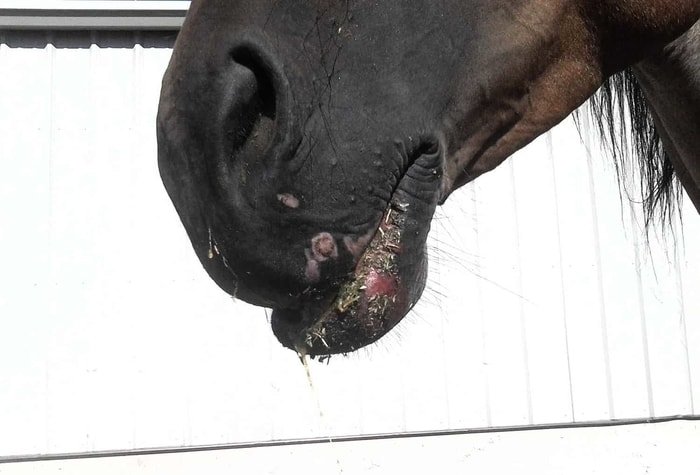
- Ulceration of the coronary band is common and results in lameness, which in severe cases may culminate in the sloughing of the hoof.
- Unless complicated by a secondary bacterial infection, the oral lesions usually heal within a couple of weeks.
- Injuries on the feet may take longer because of secondary infection, and trauma.lameness may persist if a horse develops a severe coronitis and cracked hoof walls.
- Mortality is rare but may occur if there is a critical secondary bacterial infection of the mouth, which hinders the animal from eating or drinking.
Diagnosis of Vesicular Stomatitis
A definitive diagnosis of vesicular stomatitis can be made by:
- isolating the virus from the vesicular fluid or
- by serologic examination of two blood samples collected 10-14 days apart.
- Seroconversion can be detected by the CFT or by SNT.
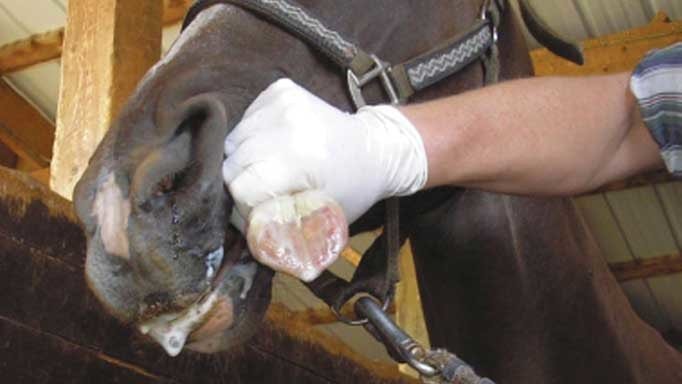
Management and Control of Vesicular Stomatitis in Horses
- Vesicular stomatitis is a notifiable disease in the US and in the EC.
- Infected horses should be isolated and supplied with ample water and soft, palatable feed.
- The use of systemic antibiotics may be indicated if the horse has a secondary bacterial infection.
- Fluid therapy and nasogastric tube feeding are indicated if the horse is unable to eat or drink.during outbreak care should be taken to avoid any injury or abrasions to the hoofs.
- Involvement of the feet may necessitate treatment similar to that employed in cases of laminitis.
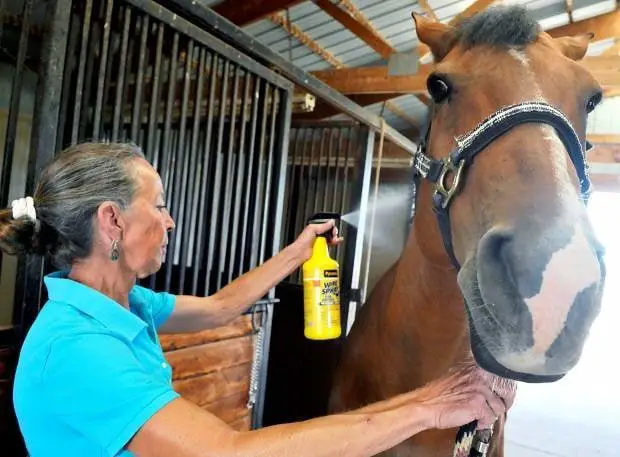
- If the disease is present in an area, insect control and the removal of animals from wooded pasture and their confinement in stables will help to curtail the spread of the virus.